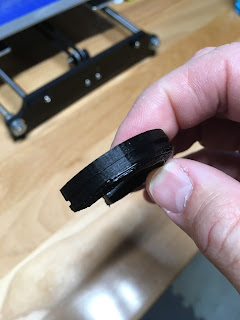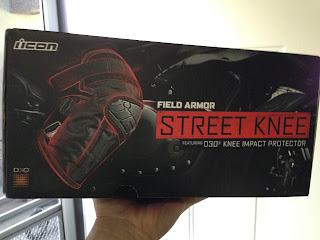Advanced technology applied to my budget road racing game.
A while ago in this post I showed you a box with some cryptic Chinese characters on the side. After a few months of assembly, trial and error as well as other projects, I'm all set to reveal what that box contained. During the November holiday season I finally got off my butt to open the box and get the contents assembled. It is not your ordinary shop tool, but something that should be fun to combine with my motorcycling for an Engi-nerd like me. I purchased a 3-D printer. Follow along as I experiment with Motorbike related prints to bring rapid photo-typing and additive manufacturing into the My Motorbike Obsessions shop.
After watching a few dozen YouTube videos related to various ways to up the game in my shop, I wanted to get some new tools for more in depth projects. I have been pining away at bench lathes, mills and CNC machines for a good long time. None of them ever had the cost to payback ratio I was looking for. By that I mean how much does the equipment cost compared to when I will be getting payback in the form of useful products from it. I then happened on a series of videos about the Anet A8 3-D printer. It is a clone of another popular printer. It comes from China as most clones do, but it could be had for as low as $155! For that kind of money I didn't really see that down side of giving it a try. It came in the aforementioned box ready for me to assemble. After watching more videos, and leafing through the pdf assembly manual with some questionably translated instructions I had it ready for my first print. In the picture above you can see the results of one of my early prints. This was an experiment in 3-D printing and printing for the motorbike. It is an adapter to go on my OEM Ninja 250 throttle tube to give it a quick opening throttle action.
Here is the printer in action on the second try. For this experiment I found a file from a popular 3-D printing file site that was a quick acting throttle adapter. I had no idea if it would fit the Ninja's old OEM throttle, but it would be fun to try. I tried to print it two or there times to get a part that I was happy with. These kit type printers requires the user to be very involved with the machine. Since I like to tweak and tinker, it is perfect for me. If you don't know a wrench from a screwdriver, you may want to get something more expensive that requires less set up and adjustment. The picture on the right is the third try at getting the print right. I was ready to try to see if it would work as a race action throttle for the Ninja race bike. To get to the third try, I had to download some free software and study how to use it. By choosing a pre-modeled file I was able to break my learning into chunks. Getting the right settings for the type of plastic and the shape of the part left me with some plastic scrap. It was much cheaper than trying to make a similar part in other ways and the cycle time between tries was very quick.Once I had a working part it was time to test. I measured the throttle action with the current throttle tube. In this post I detailed the installation of a Yamaha R6 throttle tube in place of the OEM throttle tube. It is a popular mod that people do in the little Ninja community for quicker throttle opening. With the old tube, I would have to adjust my grip to get to full throttle at the track. By changing out the throttle tube I could get to full throttle without readjusting my hand position. In the left picture I marked full closed throttle to full open throttle. Ideally I would get the 3-D print to reduce the rotation so that I could go to full gas with a quick twist of the wrist. The picture on the right shows the ultimate results. The piece of tape with all of the sharpie marks has the full open throttle positions for four experiments. The bottom line is the OEM Ninja 250 at full open. The second from bottom is my first adapter of my own design. with a 40 mm outside diameter. The top line is actually two results. One is the result of a 42 mm outside diameter adapter and it is also the R6 throttle tube at full go. Ultimately I won't able to get any better results with my 3-D prints than something that was already on the market. The benefit however came with me learning how to do the 3-D modeling and printer setting tweaks that were required to get this far. This print didn't work as planned, but I'm still happy with the result. To make the part for myself I had to learn some 3-D modeling. I haven't done that since college a decade ago and the capabilities of solid modeling programs have really gotten stronger.
I took the knowledge gained from the throttle project and designed several more prints from scratch as well as downloading other designs to give them a try. In this picture you can see new plastic pins to replace the broken ones on the side panel. A motorcycle cruise control lever for the Yamaha FZ1 and some spacers for the axles of my Harbor Freight rear stand's replacement wheels. The pins and spacers took several modeling attempts and printing attempts each. Again the ability to measure, model, print and test was something like a 1 hour cycle. Within a day I had all of these parts perfected enough to use. My creative juices really got flowing and more plastic was melted for other ideas.
Some of those other ideas were wrench holders to better organize my tool box, a couple of toys including a fidget spinner for my daughter, some dirt bike models for a buddy to make into vest pins for his Harley riding group and some key chain sport bike models just for the hell of it. Some of my future plans include a choke lever attachment for my carbs on the Ninja. I removed the left handle bar switch and now I have to sit and hold my choice open at the track while the bike warms up. I also want to make a bezel for a race tachometer and maybe a lighter weight front number plate support.
The possibilities are pretty much endless especially as I get better at 3-D modeling. I will also work on combining 3-D printing with other manufacturing methods that I can do at home. At one time before kids were part of the picture I used to melt aluminum in a homemade foundry. It would be fun to see what I could create by combining those processes somehow. To celebrate my 3-D printing success, I think I will do some kind of promotion or giveaway involving some of my prints. Once I get the details settled, you'll be the first to know about them fans. Until next time, see you at the track!
Blue










Comments
Post a Comment
Thanks for your comments and for following My Motorbike Obsessions!